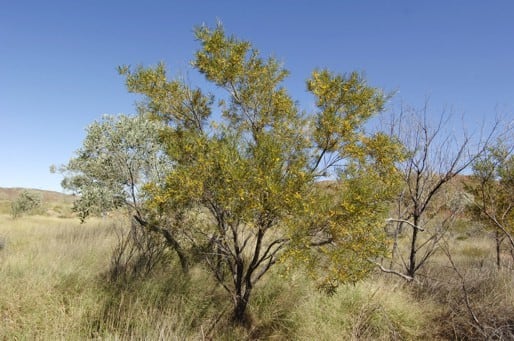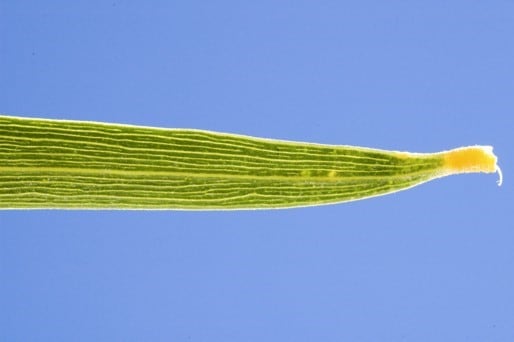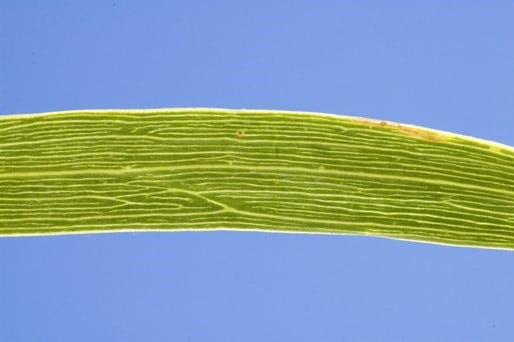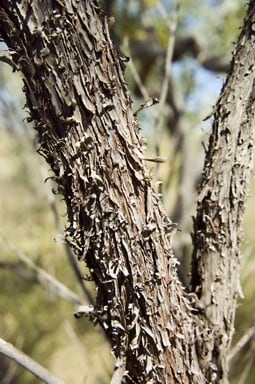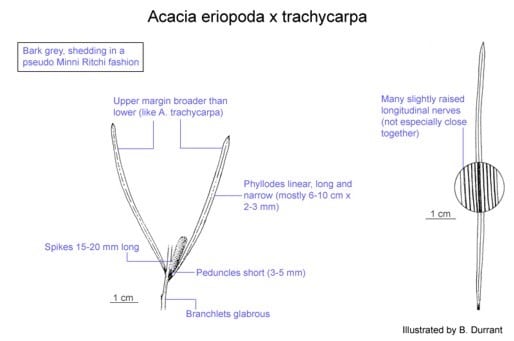Acacia eriopoda Maiden & Blakely x Acacia trachycarpa E.Pritz.
WATTLE
Acacias of Australia
Family
Fabaceae
Distribution
Known only from the Pilbara region in north-western W.A. where it occurs on Woodstock Stn and from between Marble Bar and Nullagine.
Description
Obconic shrub or tree 2.5–6 m high. Bark pseudo ‘Minni Ritchi’ (i.e. grey and peeling in short, irregularly longitudinal plates that are flat or slightly recurved at the ends, the underlying new bark pale brown). Branchlets glabrous. New shoots resinous. Stipules 0.5–1 mm long. Phyllodes linear, acute to obtuse mucronate, 6–10 cm long, mostly 2–3 mm wide, ±straight, ascending to erect, slightly resinous, glabrous, dark green; longitudinal nerves numerous and (at least when dry) slightly raised, central nerve the most pronounced, minor nerves ±widely spaced (c. 0.2–0.3 mm apart) and occasionally anastomosing, upper margin c. 0.3–0.4 mm wide (broader than lower margin). Inflorescences simple, 1–3 per axil; spikes 15–20 mm long, light golden, showy; peduncles 3–5 mm long, glabrous or with sparse, ±appressed hairs (often embedded in resin). Flowers 5-merous; calyx dissected for about ½ its length. Pods and seeds not seen.
Phenology
Flowers May–Aug.
Habitat
Grows in unconsolidated (stony) sand along creek in low granite hills.
Specimens
W.A.: Mt Edgar Stn, N.T.Burbidge 1117 (PERTH); 19.5 km ESE of Woodstock HS on rd to Hillside Stn, B.R.Maslin 8498 (CANB, MEL, PERTH); 12.5 km S of Marble Bar on rd to Corunna Stn, B.R.Maslin 8750 (K, PERTH).
Notes
The hybrid status of this entity is based on field observations and morphology of bark, phyllodes and peduncles. It has been observed to occur at low frequencies in populations containing both A. eriopoda or A. trachycarpa. The bark is grey in colour (as in A. eriopoda) and exfoliates in short, narrow, strips which, unlike A. trachycarpa are mostly very slightly recurved at the ends (A. trachycarpa has typical ‘Minni Ritchi’ bark which is burgundy to red-brown in colour, and sheds in strips that are strongly recurved at the ends to form scrolls while still attached to the stem). Flowering branches of the putative hybrid have the general facies of A. eriopoda in phyllode morphology and in having very short peduncles. The putative hybrid is distinguished, however, by its phyllodes which possess a distinctly broadened upper margin (as in A. trachycarpa, but not in A. eriopoda) and with fewer, more pronounced and more widely spaced nerves, and its peduncle indumentum commonly sparser. Acacia trachycarpa also hybridizes with A. monticola and A. tumida var. pilbarensis in the Pilbara. See B.R.Maslin et al., Wattles of the Pilbara CD-ROM (2010), for further discussion.
FOA Reference
Flora of Australia Project
Author
B.R.Maslin
This identification key and fact sheets are available as a mobile application:
URL: https://apps.lucidcentral.org/wattle/
© Copyright 2018. All rights reserved.
